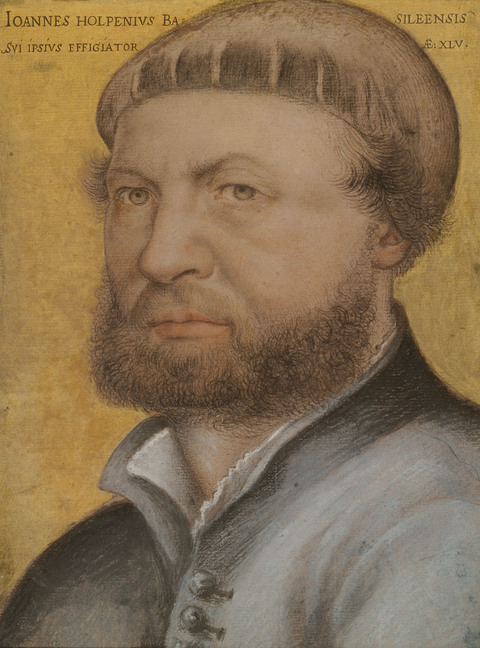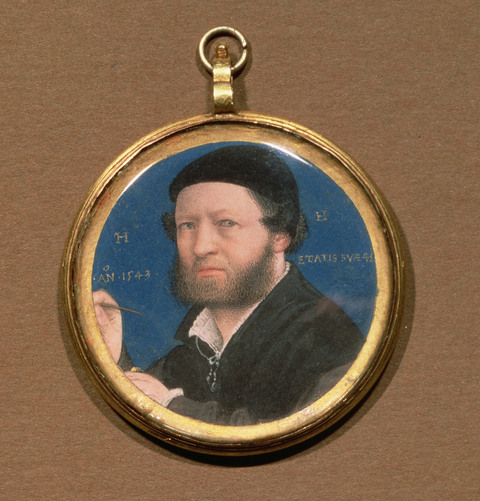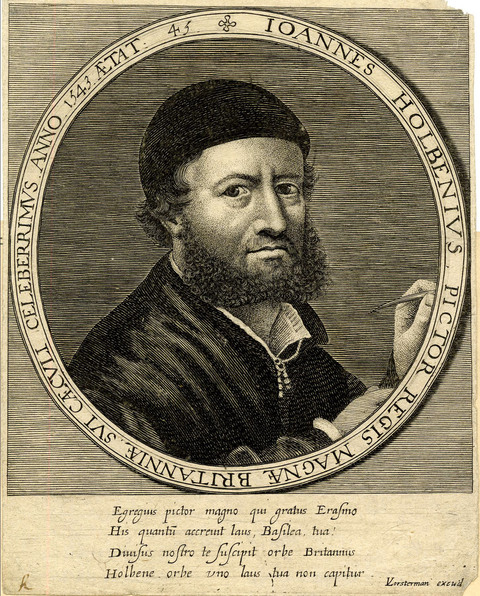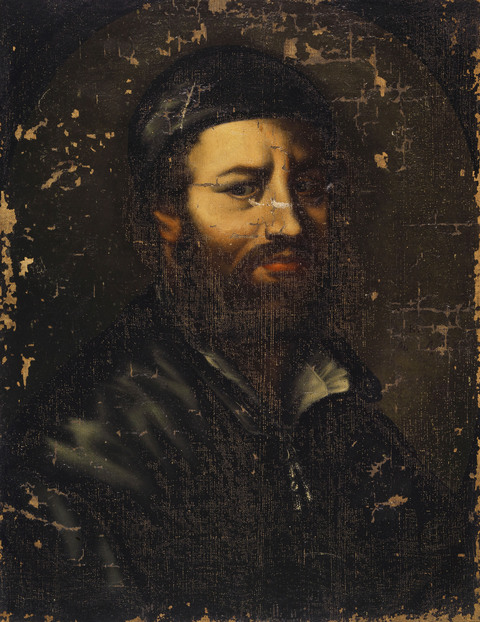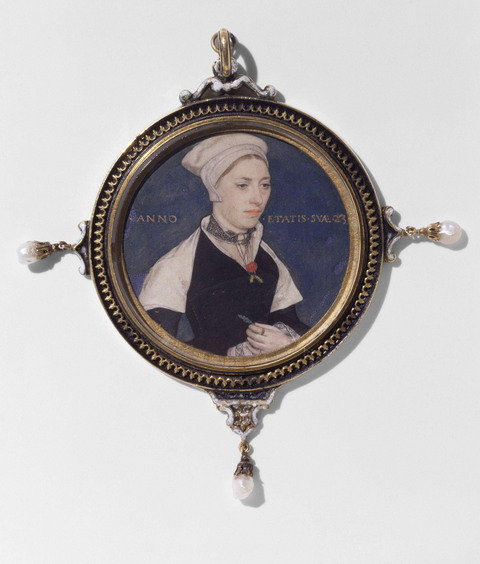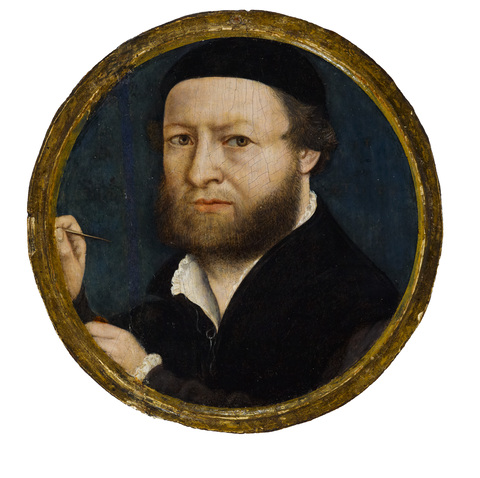Marks, Inscriptions, and Distinguishing Features
Monogrammed on background on each side of the head: HH
Inscribed: AN. 1542; AETA 45
Entry
On Wednesday, 28 October 1936, the art dealer Abris Silberman, of the E. and A. Silberman Galleries in New York, arrived at Union Station in Dayton, Ohio, to great fanfare. He carried a small wooden case containing a miniature painting, approximately four inches in diameter, thought to be a self-portrait of the artist Hans Holbein the Younger (1497/1498–1543). As reported in the Dayton Journal, this portrait, which was to make its American debut at the Dayton Art Institute, was “the highest priced picture in the world for its size." Following its exhibition in Dayton, the painting traveled to the Dallas Museum of Fine Arts. Soon thereafter it was purchased by Dr. George H.A. Clowes and eventually donated to the Indianapolis Museum of Art.
Painted in oil on a circular wood panel, the Clowes work is in many ways a traditional portrait miniature. The dark blue background was customary for such images, as was the inscription, which provides the sitter’s name and age: “HH / AN. 1542; AETA 45” (HH, year 1542; age 45). The brushstrokes are very fine, so as to be barely visible to the naked eye, and the body clearly stands out against the opaque background. While the edges are slightly abraded, the faint remnants of a gilded border are visible at the upper left and lower right of the panel.
Other aspects of this portrait are more peculiar. For instance, miniature portraits were often painted on vellum and then affixed to a thicker paper surface like a playing card; this example, however, is painted on a wooden panel. Furthermore, Holbein looks directly out at the viewer, his eyes bright and searching, a few dabs of white paint highlighting each iris and the folds of his carefully delineated eyelids. In many portrait miniatures, the sitter is portrayed with face and eyes averted, gazing off into the distance or downcast with stoic self-possession.
Perhaps most remarkable is that the artist’s hands are both visible. Holbein holds a paintbrush in his right hand, angled as if he were in the process of painting the very portrait on display. This pictorial conceit was made famous by Parmigianino in his 1524 Self-Portrait in a Convex Mirror (Vienna, Kunsthistorisches Museum), and draws attention to the artist’s technical abilities, thus allowing the piece to function both representationally and as a performance of skill. The portrait is also painted on a convex panel, suggesting a convex mirror, though this is most likely due to the warping of the wood over time. Such characteristics might ultimately be seen as examples of metapainting, which Lorenzo Pericolo, writing after Victor Stoichita, defined as “the self-staging of painting in painting." This portrait, however, was painted after Holbein’s death, leading us to ask a very different set of questions.
Correspondence between George H.A. Clowes and Paul Ganz—the Swiss art historian who first attributed the portrait to Holbein—bears witness to the shifting opinions on the picture’s authorship. The letters, which begin in about 1950, are collegial and congratulatory. Ganz provides updates on his newest publications, making sure to note the entries relevant to works in Clowes’s personal collection. By 1954, however, scholars had begun to doubt the attribution to Holbein. Clowes wrote to Ganz’s son Felix about the art historian H.A. Schmid, who had “criticized [Ganz’s] conclusions regarding the self portrait by Holbein now in my possession." In his 1951 article in Burlington Magazine, Fritz Grossmann summarized the state of the question and the disagreement between Ganz and Schmid, ultimately agreeing with the latter, although he notes that “the poor condition of this version, however, does not permit a decision as to its genuineness."
Several factors contributed to this suspicion about the portrait’s attribution. Some came from the actual painting: for example, Holbein was known to have been left-handed, but in the Clowes portrait, the paintbrush is in his right hand. Other clues were less obvious. The painting is inscribed in gold leaf with the date 1542 and the sitter’s age, 45. These dates correspond to Holbein’s age and the year the painting was believed to have been finished, one year before the artist’s death. But according to Ian Tyers’s 2019 dendrochronology report commissioned by the Indianapolis Museum of Art in 2018, the panel was painted on oak that was felled after about 1544. This information confirms that the painting could not have been painted by Holbein.
The artist’s decision to include the incorrect date and age was probably twofold. One, it allowed the painting to masquerade as an autograph Holbein, thus equating the follower’s technical skill with that of his predecessor. Two, the inscription corresponds to one in a colored chalk and pen drawing (fig. 1), regarded as an autograph Holbein, that is the source of the Clowes panel and many other posthumous portraits of the artist.
Figure 1: Hans Holbein the Younger (German, 1497/1498–1543), Self-Portrait, about 1543, colored chalk and pen on paper, 10-15/64 × 12-19/32 in. Uffizi Gallery, Florence. Photo Credit: Scala / Art Resource, NY.
Figure 1: Hans Holbein the Younger (German, 1497/1498–1543), Self-Portrait, about 1543, colored chalk and pen on paper, 10-15/64 × 12-19/32 in. Uffizi Gallery, Florence. Photo Credit: Scala / Art Resource, NY.
The Uffizi drawing is approximately three times the size of the Clowes panel (although it is believed to have been enlarged and reworked). Its inscription—which was added later but, according to John Rowlands, “records an earlier one, of which slight traces remain”—notes Holbein’s Basel origins and his age, 45. There are many similarities between the Indianapolis painting and the Florence drawing. In both, the artist’s beard suggests a strong, square jawline, and his left eyebrows curve at dramatic angles. He wears a frilled undershirt under a fitted doublet, although it has buttons in the original drawing and in the painting it ties at the neck. This drawing is undoubtedly the model for the portrait miniature, although some significant departures from the original composition, such as the addition of the artist’s hands and his direct, outward gaze, are evident.
The Clowes painting is not the only portrait based on Holbein’s drawing in Florence. At least three other miniatures are known: one at the Wallace Collection, London (fig. 2); one in the Duke of Buccleuch’s collection at Drumlanrig Castle; and another that was in the Museum Mayer van den Bergh in Antwerp until it was stolen in 1975.
Although of different sizes, each portrait shares the same compositional idiosyncrasies, such as the paintbrush and the circular format. Because of these similarities, we may assume the existence of a now-lost drawing or print after the Uffizi work that served as the model for all three miniature portraits. This was certainly the case for later, seventeenth-century copies of the Holbein portraits; printmakers Richard Gaywood (1644–1680), Wenceslaus Hollar (1607–1677), and Lucas Vorsterman I (1595–1675) each produced an etching or engraving after the miniature portrait (fig. 3). These prints then became the models for later copies of the original Holbein self-portrait, like the painting by Johannes Lüdin (active 1636–1667) (fig. 4) at the Kunstmuseum Basel, which is laterally reversed from the Uffizi drawing. The Kunstmuseum also owns a small portrait painting on paper that adheres closely to the original drawing.
Figure 2: Unknown artist, Hans Holbein the Younger, mid- or late 16th century, gouache on vellum on playing card, 1-27/64 (diam.) in. The Wallace Collection, London, M203. Photo © Wallace Collection, London, UK / Bridgeman Images.
Figure 2: Unknown artist, Hans Holbein the Younger, mid- or late 16th century, gouache on vellum on playing card, 1-27/64 (diam.) in. The Wallace Collection, London, M203. Photo © Wallace Collection, London, UK / Bridgeman Images.
Figure 3: Lucas Vorsterman (Flemish, 1595–1675), Hans Holbein the Younger, 1622–1628, engraving on paper, 6-9/64 × 4-27/32 in. The British Museum, London, O,6.157. Photo © The Trustees of the British Museum.
Figure 3: Lucas Vorsterman (Flemish, 1595–1675), Hans Holbein the Younger, 1622–1628, engraving on paper, 6-9/64 × 4-27/32 in. The British Museum, London, O,6.157. Photo © The Trustees of the British Museum.
Figure 4: Johannes Lüdin (German, active in Muttenz, 1636–1667), Self-portrait of Hans Holbein the Younger, about 1647–1667, oil on canvas, 24-7/32 × 18-45/64 in. Kunstmuseum Basel, Museum Faesch, Inv. 684.
Figure 4: Johannes Lüdin (German, active in Muttenz, 1636–1667), Self-portrait of Hans Holbein the Younger, about 1647–1667, oil on canvas, 24-7/32 × 18-45/64 in. Kunstmuseum Basel, Museum Faesch, Inv. 684.
Holbein was an incredibly popular miniaturist at the court of Henry VIII (r. 1509–47), so Ganz might be forgiven for identifying the Clowes painting as a self-portrait. Holbein had arrived in England from Basel in 1526, and despite a brief return to the Continent between 1528 and 1532, he spent the rest of his career and life in the circle of the Tudor court. In London, the artist had learned miniature portraiture from the Flemish artist Lucas Hornebolte (1490–1544), who is arguably the inventor of the genre. Miniature portraiture, also known as limning, probably derived from manuscript illumination, and was painted on incredibly fine vellum substrates. Limners usually mixed raw pigments with powdered gum Arabic and sugar to produce rich, opaque colors, or gouache, and often used pure gold leaf to inscribe or embellish the finished portrait. These material aspects created a jewel-like, precious effect. Many patrons kept their portraits in specially carved, decorated boxes, adding to that impression of treasure.
According to Holbein’s early biographer, Karl van Mander (1548–1606), it is due to Hornebolte’s teachings that Holbein became such a master of the genre. Van Mander writes: “With Lukas [Holbein] kept up mutual acquaintance and intercourse, and learned from him the art of miniature painting, which, since then he pursued to such an extent, that in a short time he as far excelled Lukas in drawing, arrangement, understanding, and execution, as the sun surpasses the moon in brightness." Indeed, Holbein was said to be so skilled, and in such high demand, that when the artist Nicholas Hilliard (1547–1619) wrote his treatise The Art of Limning in 1600, he confessed that “Holbein’s manner of limning I have ever imitated, and hold it for the best."
Throughout his career, Holbein was renowned for his ability to assimilate new genres and styles of image making into his work. He spent time in France in 1524 and possibly 1532, where he was influenced by the work of Italian, French, and Franco-Flemish artists. According to Jochen Sander, these encounters gave rise to a “gradual change in his mode of artistic expression." He attempted, unsuccessfully, to find employment at the French court, demonstrating his familiarity with the work of the French court painter François Clouet (about 1516–1572), who also worked as a miniaturist. By the time he arrived in England, he would have recognized the value the miniature portrait held for the royal courts, which Roy Strong described as “an aesthetic expression of the ruling house."
With the guidance of Hornebolte, Holbein quickly became a master of miniature portraiture. Several such portraits survive in excellent condition, like the 1532–1534 Man in a Red Cap at the Metropolitan Museum of Art, which is still in its original frame. The two letters embroidered on his coat identify the sitter as an official of the court: HR stands for Henricus Rex, or King Henry VIII. The young man is carefully delineated against a deep blue background; the outlines of his profile and doublet seem nearly to stand proud of the painting’s surface. Limners like Hilliard wrote of the importance of the line; he attributes this linear style of portraiture to the influence of Holbein.
More so than any other miniature portraitist, Holbein had a tendency to include his sitter’s hands in their portraits. For example, consider the portrait of
Mrs. Jane Small (fig. 5), datable to about 1536, now at the Victoria and Albert Museum in London. In her left hand, the sitter holds an unidentified sprig of greenery. The symbolism of this is unclear, although the red carnation at her throat might be a reference to her betrothal to Nicholas Small.
While only about 2 inches in diameter, Holbein’s painting borrows many of the conventions from the artist’s large-scale portraits completed during his time at the English court, like the well-known portraits of Thomas Cromwell or Anne of Cleves. Limners often eschewed preparatory drawings to paint directly from life. Holbein, on the other hand, continued to work from drawings, many of which survive. As Strong notes, the slippage between genres was a defining feature of Holbein’s career as a portraitist, as was the way “he stands at variance with all other exponents of the art of limning during the Tudor and Jacobean periods."
Figure 5: Hans Holbein the Younger (1497/1498–1543), Mrs. Jane Small, formerly Mrs. Pemberton, about 1536, watercolor on vellum, 2-3/64 (diam.) in. Victoria and Albert Museum, London, Purchased with Art Fund support, and the assistance of the Murray Bequest and an anonymous donor, P.40&A-1935.
Figure 5: Hans Holbein the Younger (1497/1498–1543), Mrs. Jane Small, formerly Mrs. Pemberton, about 1536, watercolor on vellum, 2-3/64 (diam.) in. Victoria and Albert Museum, London, Purchased with Art Fund support, and the assistance of the Murray Bequest and an anonymous donor, P.40&A-1935.
It is perhaps for this reason that the unidentified painter of the Clowes portrait chose to add the artist’s hands to his painting after the Uffizi drawing. But we must also consider the symbolic potential of this addition: these are hands in action. By depicting Holbein with a paintbrush in one hand, as if he were in the process of finishing his own portrait, the anonymous portraitist is suggesting that it is the act of painting itself that best represents Holbein, as much if not more than his likeness ever could.
Author
Emily Friedman
Provenance
Von Stackelberg Family, Schloss Fähna, near Reval (now Talinn), Estonia.
Reinhold von Liphart (1864–1940), Schloss Ratshoff (or Ratshof), Tartumaa, Estonia, and Gräfeling, near Munich, by at least 1928;
Emil Paravicini-Engel (born 1870), Basel, Switzerland, by 1928–1929;
(E. and A. Silberman Galleries, Vienna and New York) by July 1936;
G.H. A. Clowes, Indianapolis, in 1937;
The Clowes Fund, Indianapolis, from 1958–2014, and on long-term loan to the Indianapolis Museum of Art since 1971 (C10050);
Given to the Indianapolis Museum of Art, now the Indianapolis Museum of Art at Newfields, in 2014.
Exhibitions
Golden Gate International Exposition, San Francisco, 1939, Masterworks of Five Centuries, no. 12a;
John Herron Art Museum, Indianapolis, 1950, Holbein and His Contemporaries, no. 38;
E. and A. Silberman Galleries, New York, 1957, Art Unites Nations, no. 10;
John Herron Art Museum, Indianapolis, 1959, Paintings from the Collection of George Henry Alexander Clowes: A Memorial Exhibition, no. 36;
The Art Gallery, University of Notre Dame, Notre Dame, IN, 1962, A Lenten Exhibition, no. 28;
Indiana University Art Museum, Bloomington, 1963, Northern European Painting—The Clowes Fund Collection, no. 45;
Indianapolis Museum of Art at Newfields, 2019, Life and Legacy: Portraits from the Clowes Collection.
References
Alfred Woltmann, Holbein und seine Zeit, 2 vols. (Leipzig: E.A. Seeman, 1866–1868, 1872);
Alfred Woltmann, Holbein und seine Zeit: Des Künstlers Familie, Leben und Schaffen, 2 vols. 2nd ed. (Leipzig: E.A. Seeman, 1874–1876);
Karl Woermann, “Hans Holbein’s d.J. Selbstporträt von Schloss Fähna,” Zeitschrift für Bildende Kunst 10 (1875): 315–318;
Hermann Knackfuss, Holbein der Jüngere, 4th ed. (Bielefeld: Velhagen et Klasing, 1902), 154;
Arthur B. Chamberlain, Hans Holbein the Younger, 2 vols. (London: George Allen, 1913);
Paul Ganz, “Das Bildnis Hans Holbeins d.J.,” Jahrbuch für Kunst und Kunstpflege in der Schweiz 5 (1928–1929): 273–292;
H.A. Schmid, “Wie hat Hans Holbein d.J. ausgesehen?,” Anzeiger für Schweizerische Altertumskunde 33 (1931): 282 (reproduced);
Paul Ganz, “Henry VIII and His Court Painter, Hans Holbein,” Burlington Magazine 63 (1933): 146–155;
“Self Portrait by Hans Holbein Arrives in the United States,” Art Digest 11, 1 October 1936, 9 (reproduced);
Paul Ganz, “Holbein’s Last Self-Portrait,” Burlington Magazine 71 (1937): 62–68;
F. Grossmann, “Holbein Studies—II,” Burlington Magazine 93 (1951): 111–114;
Heinrich Alfred Schmid, “Ein unbekanntes Selbstbildniss Hans Holbeins des Jüngeren,” Das Werk 38 (1951): 27–32;
Wilhelm Waetzoldt, Hans Holbein der Jüngere (Die Blauen Bücher) (Königstein im Taunus: Karl Robert Langewiesche, 1958), frontispiece;
Paintings from the Collection of George Henry Alexander Clowes: A Memorial Exhibition (Indianapolis: John Herron Art Museum, 1959), no. 37;
Mark Roskill, “Clowes Collection Catalogue” (unpublished typed manuscript, IMA Clowes Archive, Indianapolis Museum of Art, Indianapolis, IN, 1968);
Hans Werner Grohn, L’opera pittorica completa di Holbein il Giovane (Milan: Rizzoli, 1971), 108–109, no. 134;
A. Ian Fraser, A Catalogue of the Clowes Collection (Indiana: Indianapolis Museum of Art, 1973), 178;
John Rowlands, Holbein: The Paintings of Hans Holbein the Younger (Oxford: Phaidon, 1985), 235, 239;
Jürgen Müller, “The Eye of the Artist: Hans Holbein’s Theory of Art,” Studies in the History of Art 60 (2001): 140–153.
Notes
